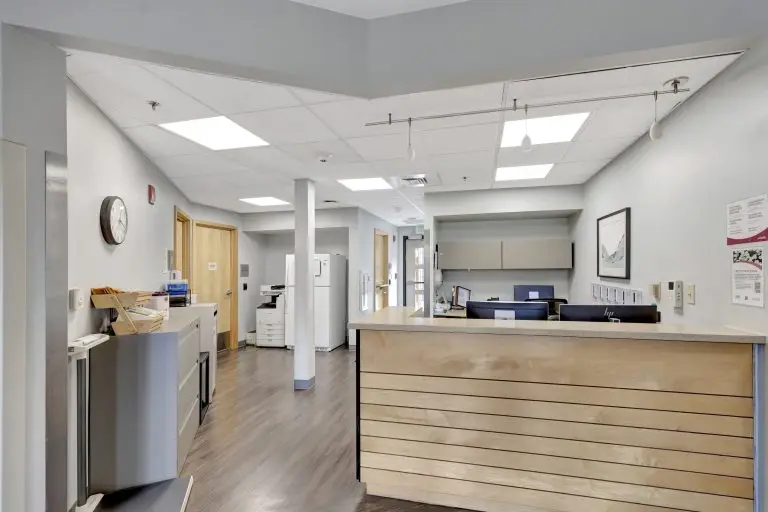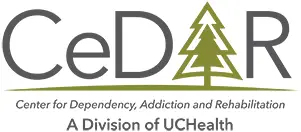At CeDAR, we believe that needing help to manage the physical dependency that comes with the disease of addiction is nothing to be ashamed of. If you have become chemically dependent on substances that are harming your health, you have suffered long enough. Every member of our staff is committed to offering the best, most compassionate, and respectful care. And our progressive treatment center will change your perception of what is possible in recovery. Our addiction treatment center is affiliated with UCHealth, and we accept many forms of insurance. To inquire about availability, please contact us by calling 720.848.3000.

Withdrawal Management (Detox) at CeDAR
Our comprehensive program provides you with the highest levels of clinical care, psychiatric evaluation, and medical supervision. From the minute you arrive, our Denver medical withdrawal management team is able to administer medications to reduce the severity of withdrawal symptoms if needed. Our experienced and knowledgeable clinicians also monitor your vital signs to keep you safe and comfortable during the detox process and onward.
Your care team will work with you to structure an individualized plan designed to take you safely and comfortably through withdrawal and detoxification. You’ll also receive a recovery plan that includes qualified guidance for your next level of care.
Chemical Dependency Is a Medical Condition
Ridding your system of harmful chemicals causes symptoms that will make you want to use even more dangerous chemicals. CeDAR provides FDA-approved medications when needed to decrease the likelihood of serious complications during medical detox. While medications can protect patients from health-related detox complications, the comprehensive treatment that takes place afterward in our residential program will help clients develop the tools they need to stay well.
Patients in our residential drug treatment program won’t need to leave our beautiful campus in order to attend treatment. From the minute you arrive, our Denver medical detox team is able to administer medications to reduce the severity of withdrawal symptoms if needed. Our experienced and knowledgeable clinicians also monitor your vital signs to keep you safe and comfortable during the detox process and onward.
Frequently Asked Questions about Medical Detox:
Do I Need Medical Detox?
Withdrawing from certain substances without medical assistance can put you at risk of life-threatening health complications. As the brain attempts to rebound from prolonged substance use, the changes in brain activity can cause seizures, vertigo, and other potentially serious health concerns including heart complications and even death. CeDAR provides FDA-approved medications, as needed, to decrease the likelihood of serious complications during medical detox. MSWAP is a medically supervised environment designed to ensure your safety when stopping the use of substances that include:
- Opioids
- Alcohol
- Benzodiazepines
- Other Drugs
During this vulnerable time, having a supportive team of medical and psychological advocates can have a profound impact on your recovery. If fear of withdrawal symptoms is causing you harm, CeDAR can help. CeDAR provides FDA-approved medications, as needed, to decrease the likelihood of serious complications during medical detox.
Will I be comfortable during withdrawal?
That is our goal. CeDAR’s medically supervised program offers an individualized experience to help you manage the discomfort of withdrawal. We use a multidisciplinary approach that may include:
- Individual Consultation with a Board Certified Addiction Medicine Provider
- Medications for Opioid Use Disorder (MOUD)
- Medications for Alcohol Use Disorder (MAUD)
- Medication Management
How long will I be in detox?
We will need to assess the severity of your symptoms to determine how long you’ll need to safely detox. With a recommended five-day length of stay, we’ll use clinical assessments to guide your progress. These assessments include:
- Nursing assessment and 24 hour nursing care
- Psychiatric evaluation
- Biopsychosocial needs assessment
What are my options after I detox?
While medications can protect patients from health-related detox complications, the comprehensive treatment that takes place afterward in our residential program will help clients develop the tools they need to stay well. Patients in our residential drug treatment program won’t need to leave our beautiful campus in order to attend their next level of treatment.
We offer the following post-detox dual diagnosis treatment options at CeDAR:
Competence, Compassion, Commitment
If drug addiction and alcoholism are holding you back from overcoming the obstacles you need to overcome, we invite you to visit our Denver detox and inpatient drug rehabilitation program. Denver provides the ideal backdrop for a person in recovery, whether you are new to the area or have spent your life here. Contact us to start your journey to health, wellness, and fulfillment.
